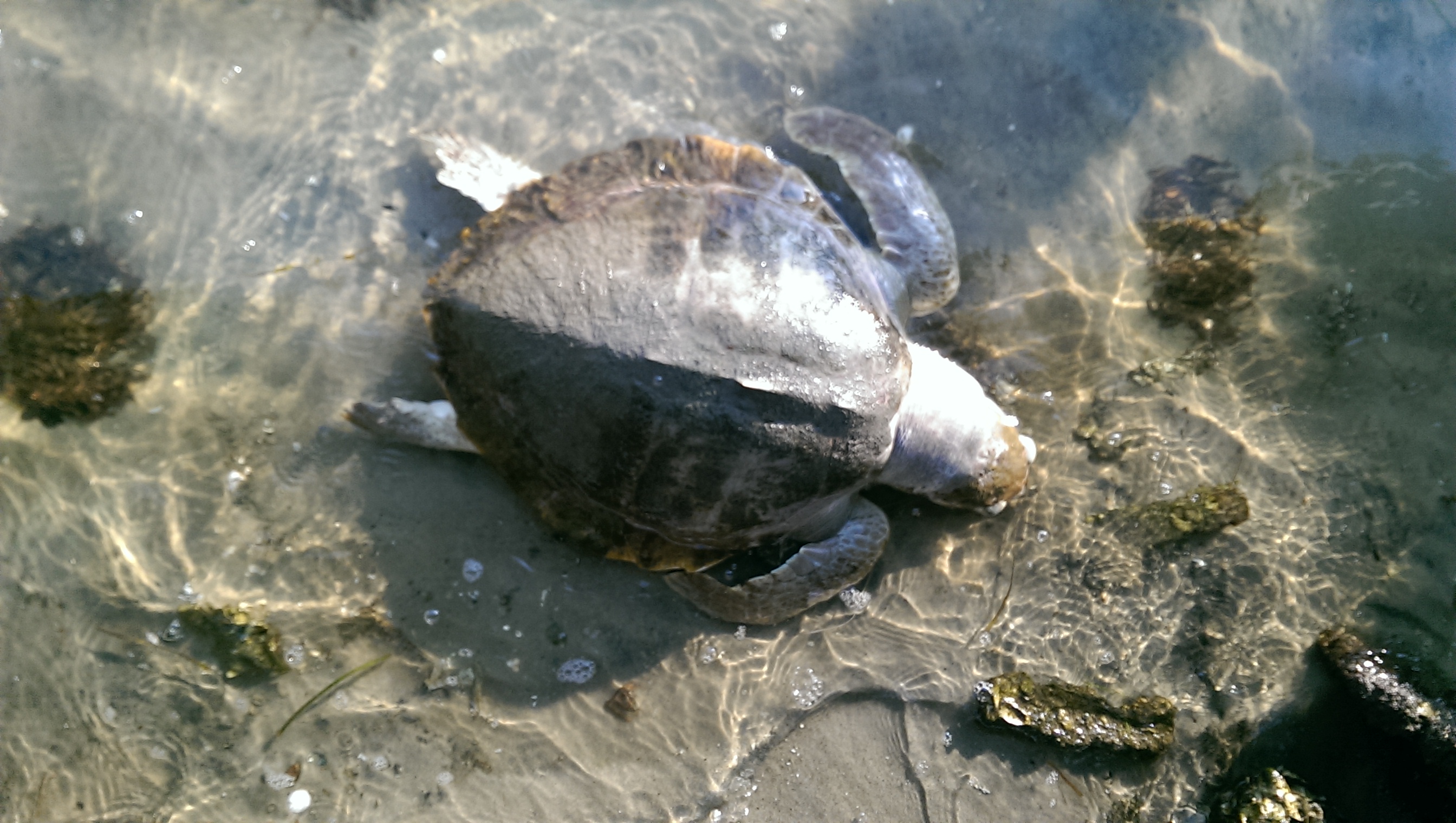
by Rick O'Connor | Feb 2, 2018
Man what a winter!
Between multiple days below freezing, tough traveling, and the flu it has been a brutal winter season so far.
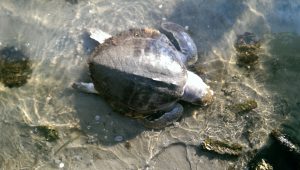
Dead Kemps Ridley Sea Turtle washed ashore in Little Sabine near Pensacola Beach. This turtle died of ingesting monofilament fishing line.
Photo: Betsy Walker
It is not that different for some of our marine wildlife friends. The low temperatures have driven marine water temperatures down as well, particularly in the shallow areas. There have been many reports of cold stunned sea turtles up and down the Florida panhandle – over 900 of them. There have been reports of cold stunned iguanas falling from trees and the loss of pythons in south Florida. The question sometimes comes up – “how do they deal with this apparent return from the dead?”
One has to remember we are dealing with reptiles – cold-blooded creatures. Actually, the more correct term is poikilothermic. It really does not pertain to the temperature of their blood but their core body temperature in general. Some animals, like humans, can maintain a constant body temperature, like 98.6°F, no matter what the environmental temperatures are – these are referred to as homotherms. Heterotherms can allow their body temperatures fluctuate within a range – but are in control of their body temperatures. The poikilotherms cannot control their body temperature and are thus at the mercy of the environment – the classic “cold blood”. Some of these poikilotherms have been known to actually freeze and thaw – with no observable problems, not so much for our “warm blooded” friends.
So what’s up with the cold-stunned situation?
Well… even with the “cold bloods”, extreme temperature changes can be very stressful. Some respond by changing their behavior, others their physiology, others both. They will alter their feeding – basically stop. In some, the pH and ion balance within their blood becomes unbalanced, which can trigger the feeding reduction response and increase ion exchange within the lungs. The partial pressure within the venous blood can decrease and this, along with the chemical imbalance and feeding reduction, can trigger a “lethargic” response and even a “floating” response in the marine turtles.
Locally, it seems to be the sea turtles who are having the most problems. In south Florida, scientists have noticed the American Crocodile and the invasive pythons struggle with these cold temperatures but the wider ranged American Alligator and numerous species of native snakes do not. The “locals” seem to alter their behavior to adjust for these extreme temperature drops – a method that the tropical species are not practicing. It is known that certain native freshwater turtles over winter in frozen ponds, and diamondback terrapins are known to “hunker down” in muddy bottoms of salt marsh creeks when water temperatures drop below 59°F.
With sea turtles, the larger migratory individuals offshore are still moving at 43°F but is the smaller inshore juveniles that are the subject of stunning events. The water temperatures change more rapidly in shallower water and at 43°F, these smaller sea turtles become lethargic and float – which increases their chance of predation. Data suggest that Green Sea Turtles begin to slow activity and Kemps Ridleys become more agitated when water temperatures drop below 68°F, both become dormant, reduce feeding and breathing when they drop below 59°F. It is believed the real problems from being cold stunned are from the reduction of food as much, if not more than, the actual temperature itself. The “cold bloods” bask to increase their body temperatures so that they can actually digest their food.
It is a problem frequently encountered along the American east coast but not as much in Florida. However, this year has been different. The staff and volunteers from government agencies and local aquaria have done a champion job rescuing and rehabilitating many of these animals.
References
Mazzotti, F. J., M. S. Cherkiss, M. Parry, J. Beauchamp, M. Rochford, B. Smith, K. Hart, and L. A. Brandt. 2016. Large reptiles and cold temperatures: do extreme cold spells set distributional limits for tropical reptiles in Florida? Ecosphere 7(8):e01439. 10.1002/ecs2.1439
Moon D.Y., D.S. MacKenzie, D.W. Owens. 1997. Simulated Hibernation of Sea Turtles in the Laboratory: I. Feeding, Breathing Frequency, Blood PH, and Blood Gases. The Journal of Experimental Zoology. 278: pp. 362-380.
Milton, S.A., P.L. Lutz. 2003. The Biology of Sea Turtles, Volume II. Edited P.L. Lutz, J.A. Musick, J. Wyneken. CRC Press. Pp. 510.

by Rick O'Connor | Jan 19, 2018
In the last article, we discussed what phytoplankton are, what their needs were, and their importance to marine life throughout the Gulf and coastal estuaries. In this article, we will discuss the different types of phytoplankton found in our waters.
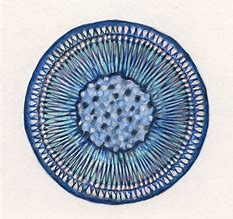
The spherical shape of the centric diatom.
Image: Florida International University
Marine scientists interested in the diversity and abundance of phytoplankton will typically sample using a plankton net. There are a variety of different shapes and sizes of these nets, but the basic design would be funnel shaped with a sample jar attached at the small end of the funnel. The plankton net would be towed behind the research vessel at varying depths for a set period of time. All plankton collected would be analyzed via a microscope. According to the text Identifying Marine Phytoplankton (1997) there are at least 14,000 species of phytoplankton and some suggest as many as 120,000. Most of these, 12,000-100,000, are diatoms, one of five classes of marine phytoplankton. The majority of the phytoplankton fall into one of two class, the diatoms and the dinoflagellates.
Diatoms are typically single celled algae encased in a clear silica shell called a frustule. The frustule can come in a variety of shapes, with or without spines, and many resemble snowflakes – their quite beautiful. They are found in the bay and Gulf in great numbers, as many as 40,000,000 cells / cup of seawater. They are the dominate phytoplankton in colder waters and are most abundant near upwellings. These are the “grasses of the sea” and the base of many marine food webs. When diatoms die, their silica shells sink to the seafloor forming layers of diatomaceous earth, which is used in filters for aquariums and oxygen mask in hospitals.
Dinoflagellates differ from diatoms in that they produce two flagella, small hair-like projections from the algae that are used for generating water currents and movement. Their shells are not silica but layers of membranes and are called thecas. Some membranes are empty and others contain different types of polysaccharides. Dinoflagellates are more abundant than diatoms in warmer waters. There are about 2000 species of them. One type, Noctiluca, are responsible for what locals call “phosphorus” or bioluminescence. These dinoflagellates produce a blue-ish light when disturbed. Many see this when walking the beach at night. Their footprints glow for a few seconds. At night, boaters can see this as their prop wash turns the dinoflagellates in the water column. The bioluminescence is more pronounced in the warm summer months and is believed to be defense against predation. The light is referred to as “cool” light in that the majority of the energy is used in producing light, not lost as heat as with typical incandescent bulbs – hence the birth of the LED light industry.
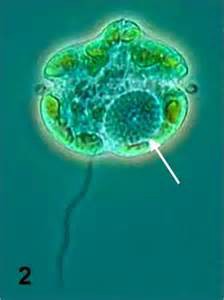
The dinoflagellate Karenia brevis.
Photo: Smithsonian Marine Station-Ft. Pierce FL
Several dinoflagellates produce toxins as a defense. Some generate what we call red tides. In the Gulf of Mexico, Karenia brevis is the species most responsible for red tide. Red tides typical form offshore and are blown into coastal areas via wind and currents. They are common off the coast of southwest Florida but occur occasionally in the panhandle. Many local red tides are actually formed in southwest Florida and pushed northward via currents. Red tides are known to kill marine mammals and fish, as well as closing areas for shellfish harvesting.
Like true plants, phytoplankton conduct photosynthesis. Between the diatoms and dinoflagellates, 50% of the planet’s oxygen is produced. These are truly important players in the ecology of both the open Gulf and local bays.
References
Annett, A.L., D.S. Carson, X. Crosta, A. Clarke, R.S. Ganeshram. 2010. Seasonal Progression of Diatom
Assemblages in Surface Waters of Ryder Bay, Antarctica. Polar Biology vol 33. Pp. 13-29.
Hasle, G.R., E.E. Syvertsen. 1997. Identifying Marine Phytoplankton. Academic Press Harcourt Brace and
Company. San Diego CA. edited by C.R. Tomas. Pp. 858.
Steidinger, K.A., K. Tangen. 1997. Identifying Marine Phytoplankton. Academic Press Harcourt Brace and
Company. San Diego CA. edited by C.R. Tomas. Pp. 858.
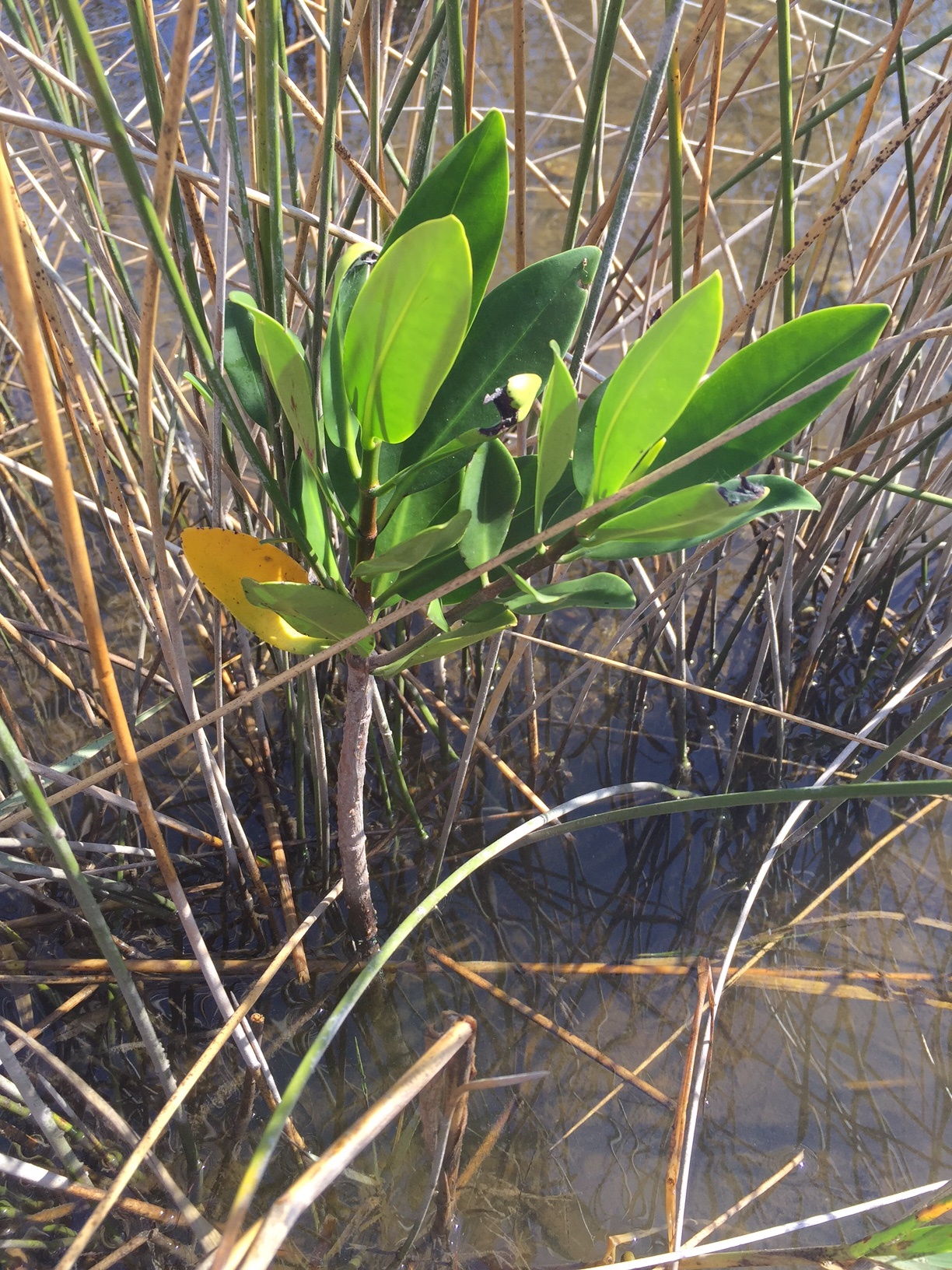
by Carrie Stevenson | Nov 3, 2017
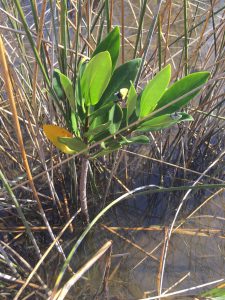
Red mangrove growing among black needlerush in Perdido Key. Photo credit: Carrie Stevenson, UF IFAS Extension
Discovering something new is possibly the most exciting thing a field biologist can do. As students, budding biologists imagine coming across something no one else has ever noticed before, maybe even getting the opportunity to name a new bird, fish, or plant after themselves.
Well, here in Pensacola, we are discovering something that, while already named and common in other places, is extraordinarily rare for us. What we have found are red mangroves. Mangroves are small to medium-sized trees that grow in brackish coastal marshes. There are three common kinds of mangroves, black (Avicennia germinans), white (Laguncularia racemosa), and red (Rhizophora mangle).
Black mangroves are typically the northernmost dwelling species, as they can tolerate occasional freezes. They have maintained a large population in south Louisiana’s Chandeleur Islands for many years. White and red mangroves, however, typically thrive in climates that are warmer year-round—think of a latitude near Cedar Key and south. The unique prop roots of a red mangrove (often called a “walking tree”) jut out of the water, forming a thick mat of difficult-to-walk-through habitat for coastal fish, birds, and mammals. In tropical and semi-tropical locations, they form a highly productive ecosystem for estuarine fish and invertebrates, including sea urchins, oysters, mangrove and mud crabs, snapper, snook, and shrimp.
Interestingly, botanists and ecologists have been observing an expansion in range for all mangroves in the past few years. A study published 3 years ago (Cavanaugh, 2014) documented mangroves moving north along a stretch of coastline near St. Augustine. There, the mangrove population doubled between 1984-2011. The working theory behind this expansion (observed worldwide) is not necessarily warming average temperatures, but fewer hard freezes in the winter. The handful of red mangroves we have identified in the Perdido Key area have been living among the needlerush and cordgrass-dominated salt marsh quite happily for at least a full year.
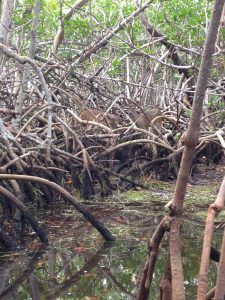
Key deer thrive in mangrove forests in south Florida. Photo credit: Carrie Stevenson, UF IFAS Extension
Two researchers from Dauphin Island Sea Lab are planning to expand a study published in 2014 to determine the extent of mangrove expansion in the northern Gulf Coast. After observing black mangroves growing on barrier islands in Mississippi and Alabama, we are working with them to start a citizen science initiative that may help locate more mangroves in the Florida panhandle.
So what does all of this mean? Are mangroves taking over our salt marshes? Where did they come from? Are they going to outcompete our salt marshes by shading them out, as they have elsewhere? Will this change the food web within the marshes? Will we start getting roseate spoonbills and frigate birds nesting in north Florida? Is this a fluke due to a single warm winter, and they will die off when we get a freeze below 25° F in January? These are the questions we, and our fellow ecologists, will be asking and researching. What we do know is that red mangrove propagules (seed pods) have been floating up to north Florida for many years, but never had the right conditions to take root and thrive. Mangroves are native, beneficial plants that stabilize and protect coastlines from storms and erosion and provide valuable food and habitat for wildlife. Only time will tell if they will become commonplace in our area.
If you are curious about mangroves or interested in volunteering as an observer for the upcoming study, please contact me at ctsteven@ufl.edu. We enjoy hearing from our readers.
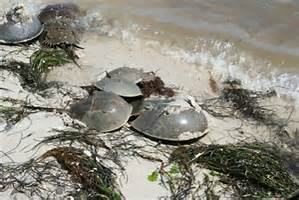
by Rick O'Connor | Oct 6, 2017
Back in the spring, I wrote an article about the natural history of this ancient animal. However, Florida Fish and Wildlife Conservation Commission (FWC) is interested in the status of horseshoe crabs and they need to know locations where they are breeding – and Florida Sea Grant is trying to help.

Horseshoe crabs breeding on the beach.
Photo: Florida Sea Grant
If you are not familiar with the horseshoe crab, it is a bizarre looking creature. At first glance, you might mistake it for a stingray. It has the same basic shape and a long spine for a tail. But further observation you would realize it is not a stingray at all.
So then… What is it?
When you find one, most are not comfortable with the idea of picking it up to look closer. The spine is probably dangerous and there are numerous smaller spines on the body. Actually, the long spine in the tail region is not dangerous. It is called a telson and is most often used by the animal to push through the environment when needed, as well as righting itself when upside down. It is on a ball-and-socket joint and if you pick them up, they will swing it around – albeit slowly – but it is of no danger. Note though, do not pick them up by the telson – this can damage them.
If you do try to pick them up with your hands on their sides, you will find they are well armored and have numerous clawed legs on the bottom side. At first, you are thinking it is a crab, and the claws are going to pinch, but again we would be mistaken. The claws are quite harmless – they even tickle when handled. I have held them to allow kids to place their hands in there to feel this. However, when held they will bend their abdomen between 90° and 120°, as if attempting to roll into a ball – which they cannot. At this point, they become difficult to hold. Your hands feel they are in the way and the small spines on the side of the abdomen begin to pierce your skin. So, you flip it on its back. It begins to try a 90° bend in the other direction and begins to swing the telson around. This is probably the most comfortable position for you to hold – but I am not sure what the crab thinks about it.
So, what do you have?
Well, you can see why they call it a crab. It has clawed legs and a hard shell. The body is very segmented. You can also see why it is called a “horseshoe”. But actually, it is not a crab.
Crabs are crustaceans. Crustaceans have two body segments – a head and abdomen, no middle thorax as found on insects. This is the case with the horse crab as well.
Crustaceans have 10-segmented legs, though the claw (cheliped) and swimming paddles (swimmerets) of the blue crab count as “segmented legs”. Horseshoe crabs have 10 as well – seems this IS a crab – but wait…
Crustaceans have two sets of antenna – two short ones and two long – horseshoe crabs do not have any antenna. Traditionally biologists have divided arthropods into two subphyla – those with antenna and those without – so the horseshoe crab is not a crab. It is actually more closely related to spiders, ticks, and scorpions.
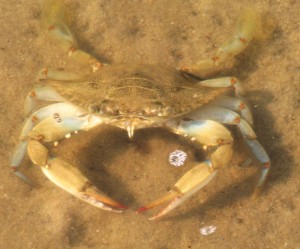
Blue crabs are one of the few crabs with swimming appendages.
Photo: Molly O’Connor
It is an ancient animal, fossil horseshoe crabs in this form date back over 440 million years – out dating the dinosaurs. There are four different species of today and there probably were more species in the past. Their range extends from the tropics and temperate coastlines of the planet. Today three of the remaining four species live in Southeast Asia. The fourth, Limulus polyphemus, lives along the eastern and Gulf coast of the United States.
Unfortunately, this neat and ancient creature is becoming rare in some parts of its range. There is a commercial harvest for them. Their blood is actually blue and contains properties beneficially in medicine. Smaller ones are used as bait in the eel fishery, and there is always the classic loss of habitat. These are estuarine creatures and are often found in seagrass and muddy bottom habitats where they forage on bottom dwelling (benthic) animals.
FWC is interested in where horseshoe crabs still breed in our state. Some Sea Grant Agents in the panhandle are assisting by working with locals to report sightings. Sea Grant also has a citizen scientist tagging program to help assess their status. Horseshoe crabs typically breed in the spring and fall during the new and full moons. On those days, they are most likely to lay their eggs along the shoreline during the high tide. This month the full moon is October 5 and the new moon is October 19. We ask locals who live along the coast to search for breeding pairs on October 4-6 and October 18-20 during high tides. If you find breeding pairs, or better yet, animals along the beach laying eggs – please contact your local Sea Grant Agent. We will conduct these surveys in the spring and fall of 2018 and post best search dates at that time.
For more information on the biology of this animal read http://escambia.ifas.ufl.edu/marine/2017/04/10/our-ancient-mariner-the-horseshoe-crab/.
References
Barnes, R.D. 1980. Invertebrate Zoology. Saunders College Publishing. Philadelphia PA. pp 1089.
Florida Fish and Wildlife Conservation Commission. Facts About Horseshoe Crabs https://www.sciencedaily.com/releases/2008/02/080207135801.htm
Oldest Horseshoe Crab Fossil Found, 445 Million Years Old https://www.sciencedaily.com/releases/2008/02/080207135801.htm
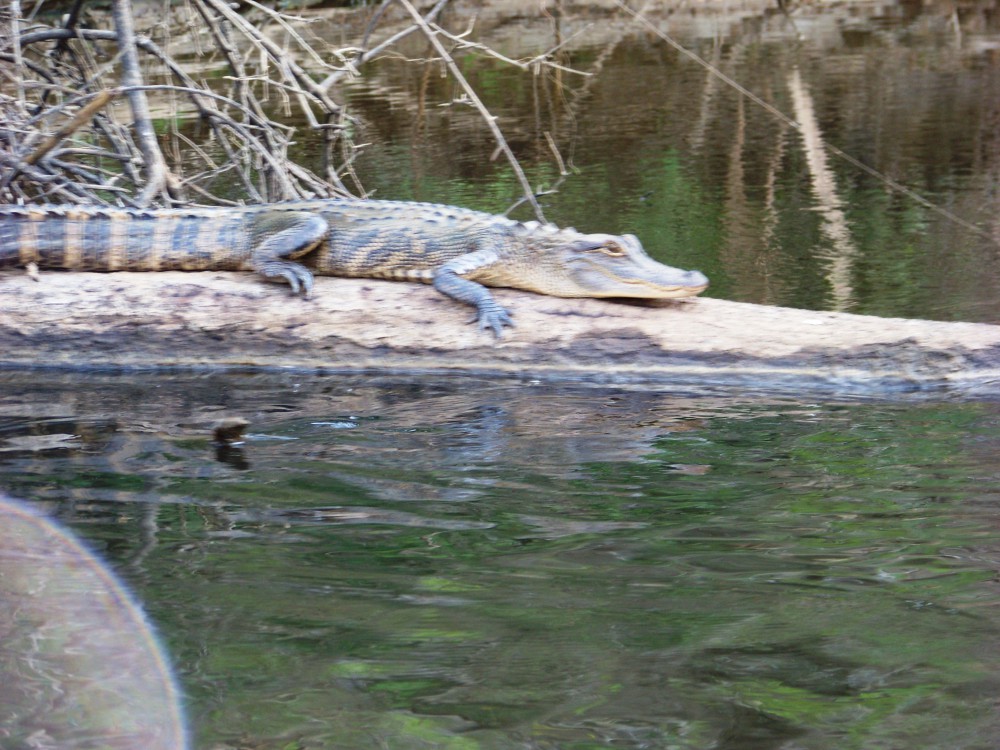
by Rick O'Connor | Sep 15, 2017
I recently saw a photograph of an American Alligator (Alligator mississppiensis) crossing Perdido Key Drive on a heavy rain day. This encounter would surprise some, and unnerve many. The majority of the nuisance wildlife calls I receive are for snakes. I have never received a call for an alligator but no doubt, my colleagues in central and south Florida have. They certainly will with the landfall of Irma. Just as humans relocate for storms, wildlife does as well. High, dry ground is a need for all, and as our friends return to their homes after the storm, they will no doubt encounter creatures in the debris that can be a bit unnerving.
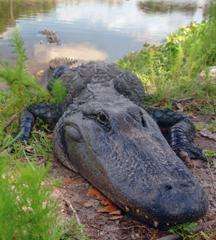
Alligator basking on a shoreline; photo: UF/IFAS Communications
“Nuisance” is in the eye of the beholder. Defined by the Merriam-Webster dictionary as being annoying, unpleasant, or obnoxious, a nuisance species is one we would rather not have in our yard. Snakes are one of those. Most of the people who call about snakes wish them no harm; they just do not want them on their porch or in their pool. Venomous snakes in particular raise anxiety levels, especially when children or pets are around. Though we do not get many calls on alligators, the feeling a homeowner would have if they found one in their driveway would be the same.
There were no calls on the alligator on Perdido Key. Actually, not everyone believed the photo to be legit. I cannot verify it, but I did receive a call earlier this summer when an American alligator was found swimming and basking on a Gulf beach in Navarre and later near Ft. Pickens. Though not as common as they are in central and south Florida, alligators do live here and they are found on our barrier islands. Though encounters with them are rare, how should a homeowner deal with this potential nuisance? When I give a program on snakes I typically go over four points. Let us go over the same with the alligators.
Is it venomous or not?
Obviously, this is not a question here – no crocodilian is venomous. They do have bacteria in their mouths that have caused problems for some who have survived an attack, but there is no venom. However, in south Florida identification is still important because there is more than one crocodilian roaming the landscape. The American Crocodile (Crocodylus acutus) is a native species found in coastal waters of south Florida, the northern reach of its range. The Speckled Caiman (Caiman crocodylus) is an exotic species from Central and South America that is now found in freshwater canals and lakes of southeastern Florida. It is likely that post Irma cleanup will include encounters with these two. However, this is not likely for the panhandle – our winters are too cold.
How do I avoid encounters?
Generally encounters with nuisance wildlife occur for one of two reasons; (a) we have moved into their habitat or (b), they have come to us.
With the population of Florida growing at an ever increasing rate, currently 21 million people and a growth rate of 1.77%, development continues to expand into habitat where these animals have remained out of our sight for some time. As we continue to move into these habitats, encounters with nuisance wildlife will increase. They will be forced to visit our yards and pools. It is no different with bears.
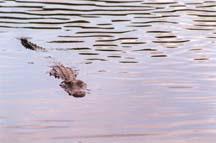
In other cases we, either knowing or unknowingly, provide food and shelter for them. Predators tend to select the easiest prey to kill, the ones that take the less energy. Human development tends to provide habitat for vermin, such as rats, in concentrated areas. This makes hunting for predators, such as snakes, bears, and alligators, much easier – and they will take advantage of this.
With alligators, (a) is more problematic than (b). Alligators have a natural fear of humans and do not typically seek us out looking for easy prey. They seem to prefer to live and hunt away from us. However, feeding alligators changes this and thus, it is a felony to do so in our state. In 2015, the state legislature developed a tiered penalty system for assessing fines and charges. As we continue to develop in areas where alligators live, it will be harder to avoid encountering them.
What do I do if I encounter one?
The general nature of wildlife is reacting to predators, prey, reproduction, and shelter. Alligators are top predators and feed on a variety of species. They are opportunistic hunters, selecting prey they can easily swallow and are relatively easy to catch. Much of these are smaller animals. If the opportunity to make a large kill presents itself, they will – however, they will drown the creature and leave it underwater to soften the carcass so they can swallow.
The method of capture usually involves lying still and waiting for prey to move within range. If encountering an alligator the questions that come to mind are: (1) am I within range? (2) are we near water? – remember they need to submerged large prey. Keep in mind that small children and pets are easier prey and care should taken when in alligator habitat.
Resources provide the following suggestions if an encounter occurs:
- They have a nature fear of humans and will try to retreat. This is true. Provide an avenue of escape for the animal. Do your best not to corner it. Remember it may react to pets and children as prey and could approach.
- If they hiss, they are warning you that you are getting too close and they are feeling threatened. Back away slowly. Sudden movements could be misinterpreted and they may defend themselves by attacking.
- Keep in mind they are fast moving for several yards, so do not think of them as slow and lethargic.
- Females guarding a nest may attack. They will charge to drive you off but typically return to the nest once you have moved to a safe distance (safe in their minds). Alligators build nests of leaf litter above ground in quiet water areas within their range. You may encounter one while hiking along shore. Avoid these nesting areas.
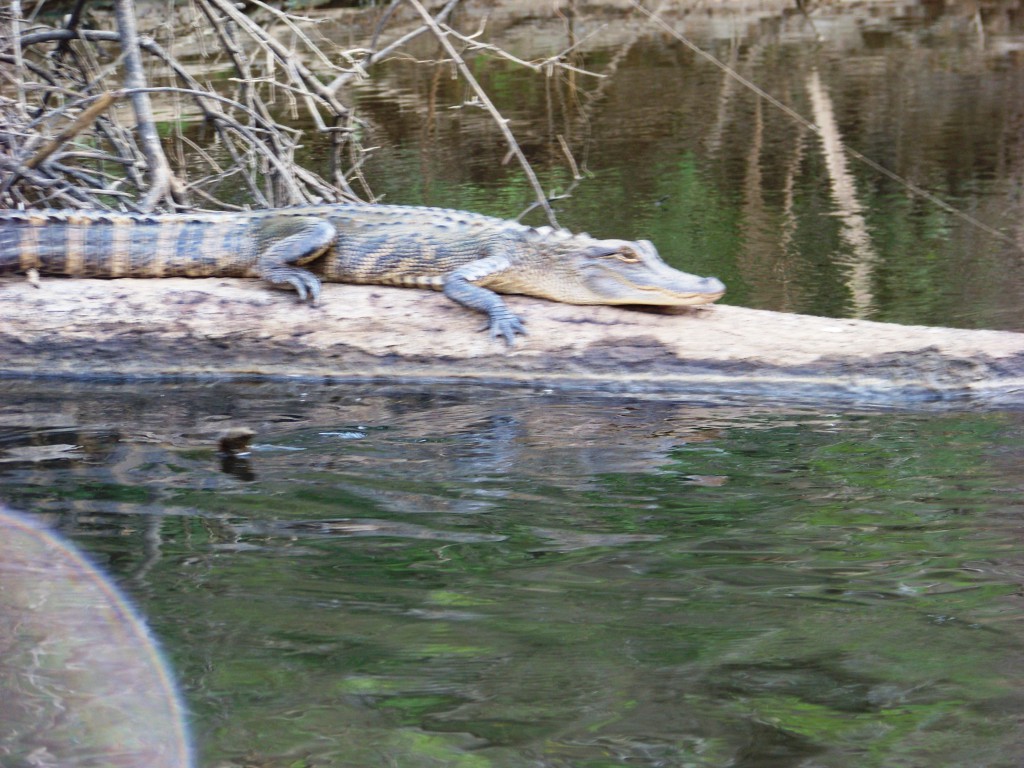
Alligator basking on the Escambia River; photo: Molly O’Connnor
And what if I’m bitten?
This question makes sense if you are talking snakes. With snakes, you are bitten and the snake withdraws. So the question comes up, now what? Not so much with alligators. Though alligators tend to feed on smaller and softer prey, as they increase in age and size, their skull structure adjust to where they can crush turtle shells and mammal bones. Forces have been recorded between 12 and 9452 Newtons, depending on age. When they bite they do not typically withdraw, but rather will drag you into water. Do whatever you can to avoid being dragged into water. Since 1948 there have been 388 alligator attacks, 24 were fatal. That averages to 6 attacks/year statewide and about 1 fatality every 4 years – so it is not very common. But remember, human development is encroaching and we will need to learn to live with them as our ancestors did when the animals were more numerous.
In Florida, an alligator is not considered a nuisance unless it is at least 4 feet in length. If you feel there is a nuisance alligator in your neighborhood you can call.
1-866-FWC-GATOR
References
American Crocodile: Species Profile. National Park Service. https://www.nps.gov/ever/learn/nature/crocodile.htm.
Caiman. 2017. Florida Fish and Wildlife Conservation Commission. http://www.myfwc.com/wildlifehabitats/managed/american-crocodile/caiman/.
Erickson, G.M., A.K. Lappin., A.K. Vilet. 2003. The Ontogeny of Bite-Force Performance in American Alligator (Alligator mississippiensis). Journal of Zoology. Vol 260 (3). Pp. 317-327. https://www.cambridge.org/core/journals/journal-of-zoology/article/the-ontogeny-of-bite-force-performance-in-american-alligator-alligator-mississippiensis/150E92D79C5FAEB821DDBF563888E773. P
Florida Population 2017: Demographics, Maps, and Graphs. 2017. World Population Review. http://worldpopulationreview.com/states/florida-population/.
Merriam-Webster Online Dictionary. https://www.merriam-webster.com/dictionary/nuisance.
Statewide Nuisance Alligator Program. 2017. Florida Fish and Wildlife Conservation Commission. http://myfwc.com/wildlifehabitats/managed/alligator/nuisance/.
Swiman, E., M. Hostetler, S. Webb Miller, M. Main. 2017. Living with Alligators: A Florida Reality. University of Florida Institute of Food and Agricultural Science Extension Electronic Data Information Source (EDIS) publication WEC203.
http://edis.ifas.ufl.edu/pdffiles/UW/UW23000.pdf.
Texas Parks and Wildlife. If You See An Alligator. https://tpwd.texas.gov/huntwild/wild/species/alligator/safety/index.phtml.
Wildlife Feeding Rules and Penalties. 2017. Florida Fish and Wildlife Conservation Commission. http://myfwc.com/news/resources/fact-sheets/feeding-rules-and-penalties/.
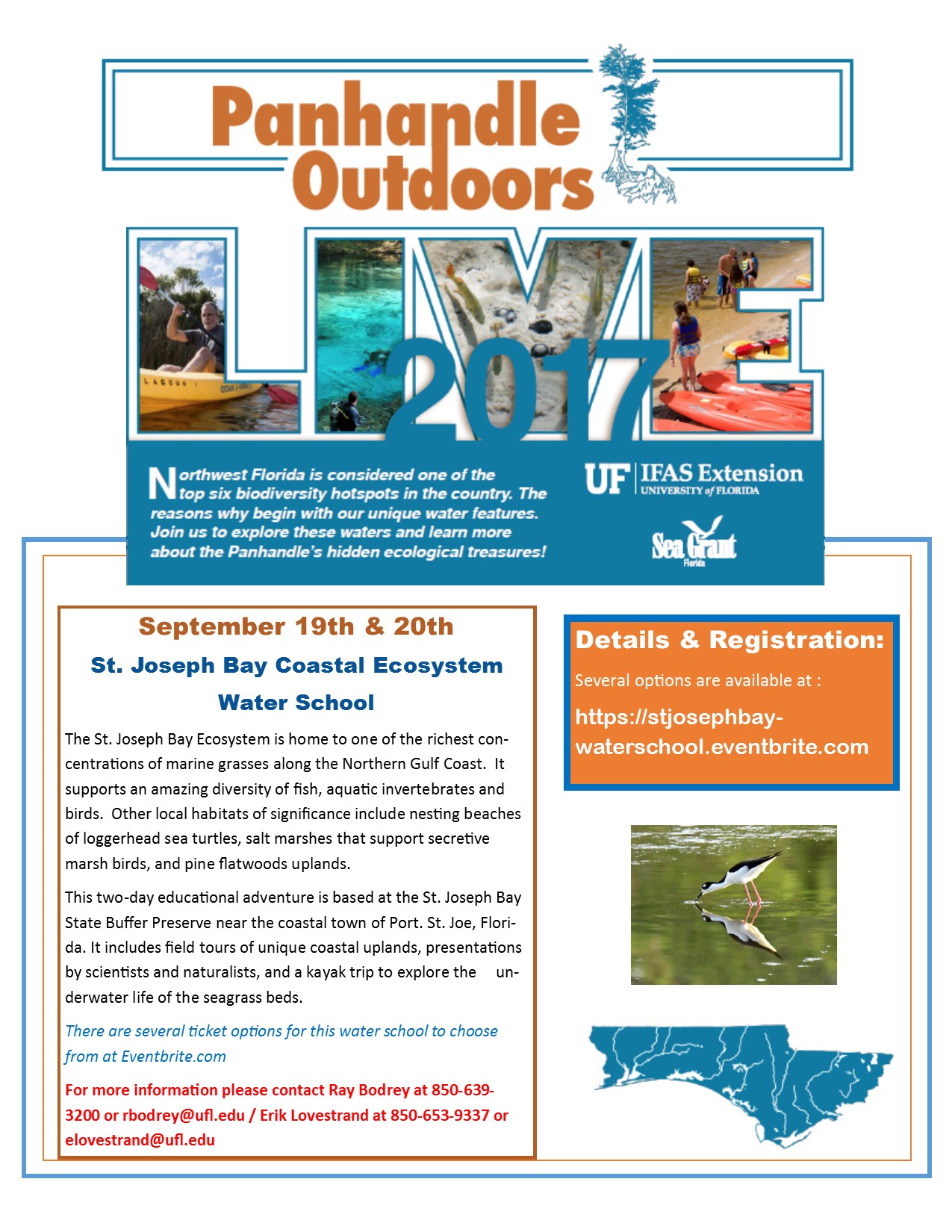
by Rick O'Connor | Aug 11, 2017
Our first POL program will happen this week – August 17 – at the Navarre Beach snorkel reef, and is sold out! We are glad you all are interested in these programs.
Well! We have another one for you. The Natural Resource Extension Agents from UF IFAS Extension will be holding a two-day water school at St. Joseph Bay. Participants will learn all about the coastal ecosystems surrounding St. Joe Bay in the classroom, snorkeling, and kayaking. Kayaks and overnight accommodations are available for those interested. This water school will be September 19-20. For more information contact Extension Agent Ray Bodrey in Gulf County or Erik Lovestrand in Franklin. Information and registration can be found at https://stjosephbay-waterschool.eventbrite.com.
















